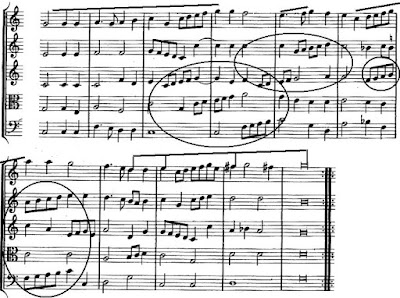Roughly 10% of the pieces have rising cadence gestures in one of their strains, more often the last than the first or an interior one. Here are three samples of interior strains to begin.
Among the galliards (a fast triple dance with only occasional play between rhythms in 3/2 and 6/4), n285 is typical in having three strains. The opening of the piece is shown below, along with all of the second strain, where the register of G5 is established immediately, the range of the melody being from there down the sixth to B4. The simplicity of the approach and the clarity of the cadence figure itself are characteristic.
In n284, the second strain initially stretches the register to an octave, starting from below, on G4 (line), but stays in the upper half once G5 is reached. In this case, each cadence note receives a consonant chord as harmonization. As point of information, like n285, the cadences in the first and third strains are on C.
(Comment: The two galliards, ns284-285, are derived from this passamezzo, though in a freer manner than would be suggested if we called them variations (note that the second strain of n284 is much closer to n283 than is the second galliard, n285). This method of variation/adaptation is commonplace in the 16th and early 17th centuries.)


